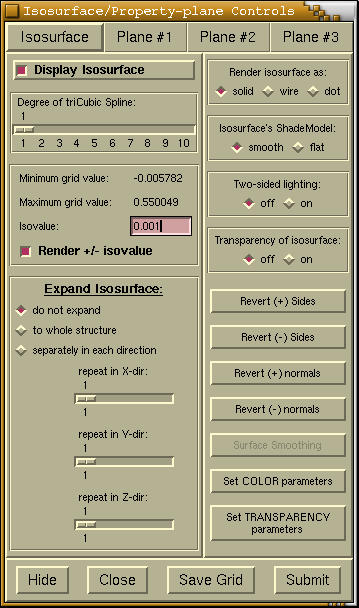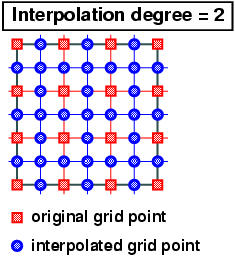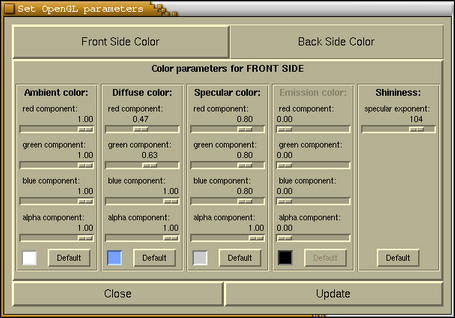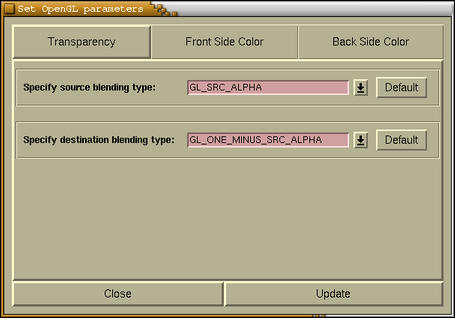XCrySDen tessellate the
isosurface from a 3D grid of values. This 3D grid of
values span some box, and beside the isosurface display
it is also possible to render the contours and
colorplanes on the slices of three basal planes of the
grid-box (what is really meant by this will be
explained below), namely, on AB, AC, and BC planes.
The isosurface display requires a lot of
parameters to be specified. Of course
XCrySDen sets those
parameters to some default values, but nevertheless
these defaults are rarely sufficient for a good quality
display of isosurface. Therefore when rendering the
isosurface the
Isosurface/Property-plane
Controls window appear shown below.
Important: as there are many items on the
below window, the figure was made
interactive in order to facilitate easier
explanation of items functions. Simply
mouse-click appropriate item (widget)
to get its explanation.

This radiobutton toggles the display of
isosurface.
Allows to interpolated the 3D grid values by
tri-cubic spline interpolation. The term
degree determines how many additional points
will be interpolated. The value of 1 means
no-interpolation, while the value of 2 means calculate
a middle points between two sequential points. Here
this is shown graphically for 2D example:

These two labels displays the minimum and maximum
grid values. The specified isolevel should be in this
range.
In this entry one specifies the isovalue
(isolevel) for the isosurface. When this value is
changes the
[Submit]
button should be pressed to load the newly
specified value and to update the display of the
isosurface.
Toggles the display of isosurface with
-isovalue value. An example: when
displaying the isosurface of a molecular orbital, then
it is a good idea to display both positive and negative
valued isosurface (for example the -0.02/0.02
sqrt(BOHR^3/electrons)). By default the positive
isosurface is rendered in red, while negative in blue.
If one does not see these colors, then she/he should
play with the
[Revert (+) Sides],
[Revert (-)
Sides],
[Revert (+) Normals],
[Revert (-)
Normals] buttons. The functions of these buttons is
explained bellow.
The radiobuttons and scales on this frame only
appears for periodic structures. The widgets allows to
control the display of the periodic replicas of the
isosurface. I hope these widgets are self-explanatory
and we can try them out by testing.
Warning:
- press the [Submit]
button to update new expand setting.
- The isosurface can be expanded just to the size
of the currently displayed structure. Hence use the
Modify-->Number of
units drawn menu to change the number
of displayed unit cells.
Controls the display-style of the isosurface.
Currently the solid, wire and dot display styles are
implemented.
Controls the shading of the isosurface, which is
either smooth or flat.
Toggles the display of two-sided lighting. By
default two-sided lighting is disabled. This feature
needs some more explanation. Any surface has two sides,
which we will call the front and back sides. Now if we
render the isosurface of molecular charge density, then
this isosurface will be closed and only one side will
be visible (let's say front side). Hence we can disable
the lighting of the back side in order to gain the
rendering performance (i.e. speed). However it is very
common to get an open surface for the crystalline
structures, since we are only rendering a part of it,
namely, some number of unit cells. To correctly render
such a case, the two-sided lighting should be enabled,
otherwise the illumination of the back-side will be
incorrect. Furthermore, the choice of the front and
back sides can be quite arbitrary. Why? Let us take a
look of the charge density of the TiC crystal at two
different isovalues, that differs for the factor of 10.
The isosurface on the right figure is
rendered at 10 times lower isovalue with respect to the
left one. We can realize that what we would normally
define as front-side is different for left an right
figure. Normally I would define the blue-surface on the
left figure as a front-side and a red-surface on the
right as the front-side. Therefore, due to this
arbitrariness of the choice of the front side,
XCrySDen
provide
[Revert (+) Sides] and
[Revert (-)
Sides] buttons, which swaps the front and back
sides. The (+) button is meant for
isovalue isosurfaces, while (-) button for
-isovalue isosurfaces. Furthermore, there
are also
[Revert (+) Normals] and
[Revert (-)
Normals] buttons. Their function is the following:
sometimes the illumination of the isosurface looks as
from-the-back. In these case revert the normals to get
the correct from-the-front illumination.
Toggles the transparency of isosurface.
Sometimes the isosurface is not illuminated
correctly. Hence several command buttons exist to
improve upon that.
Swaps the front and back sides of the
isovalue (i.e. (+)) isosurface. See also
the discussion on
two-sided
lighting.
Swaps the front and back sides of the
-isovalue (i.e. (-)) isosurface. See also
the discussion on
two-sided
lighting.
Reverts the isosurface normals (i.e.
nnew = -
nold)
of the
isovalue (i.e. (+)) isosurface. See
also the discussion on
two-sided
lighting.
Reverts the isosurface normals (i.e.
nnew = -
nold)
of the
-isovalue (i.e. (-)) isosurface.
See also the discussion on
two-sided lighting.
Here we can set the color parameters for the
isosurface. When this button is pressed, the following
window appears:

In this window we see a whole bunch of
parameters, but this is how it is. To get an extensive
description of all of these refer to some OpenGL guide.
There should be plenty sides on the WEB, where the
lighting is explained. Here we just shortly summaries.
At the top of the window the [Front Side
Color] and [Back Side Color] tabs are
located. Pressing one of them displays the values of
corresponding parameters.
At the bottom we see the [Close] and
[Update] buttons. The first one closes the
window, while the latter update the current color
setting. It is mandatory to press this button to load
the new setting.
In the middle we the the Ambient, Diffuse, Specular
and Shininess parameters.
|
Ambient color
|
this is the color that the object inherits
from the environment. For example an object
will appear in different color under day
light or in some room with some artificial
color of light.
|
|
Diffuse color
|
These are the most important parameters,
since the color of the isosurface is mostly
determined by them. The red/green/blue
determines the color, while alpha is used for
transparency.
|
|
Specular color &
Shininess
|
Determine the appearance (i.e. shinnines) of
the isosurface. For example specifying the
specular color as white (1.0,1.0,1.0) and
putting the specular exponent to large value
(app. 100) will make the isosurface to appear
like a metal surface, while specifying low
specular color (0.1,0.1,0.1) will make the
isosurface to appear like a paper.
|
Please note that there are two sets of color
parameters, one for non-transparent isosurface and
one for transparent isosurface. If we press the
[Set COLOR parameters] button then we will
edit the color parameters for non-transparent mode.
To edit the color parameters for transparent mode
press the [Set TRANSPARENCY parameters]
button.
Here we can set the transparency and color
parameters for the transparent mode of the isosurface.
When this button is pressed, the following window
appears:

At the top of the window the
[Transparency],
[Front Side Color], and
[Back Side Color] tabs are located. The meaning
of the last two is the same as the ones appearing for
Set Color parameters task.
Pressing the first button displays the transparency
parameters. Refer to the any OpenGL guide for the
meaning of these parameters.
At the bottom we see the [Close] and
[Update] buttons. The first one closes the
window, while the latter update the current color
setting. It is mandatory to press this button to load
the new setting.
At the bottom of
Isosurface/Property-plane
Controls the
[Hide]/
[Close]/
[Save Grid]/
[Submit] buttons are located. The function of these
buttons is as follows:
|
[Hide]
|
Hides the Isosurface/Property-plane
Controls window. Hiding means that
window is iconified, i.e. the window
disappears and its icon appears on
XCrySDen main
render window. Pressing the icon pop-ups the
window
|
|
[Close]
|
Closes the window. The 3D grid data will be
flushed (cleared).
|
|
[Save Grid]
|
Saves the 3D grid data in XSF format.
|
|
[Submit]
|
Loads new isosurface parameters and renders
an updated isosurface.
|








![[Figure]](img/xcrysden-picture-small-new.jpg)